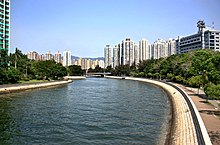Tai Po
This article needs additional citations for verification. (October 2011) |
| Tai Po | ||
|---|---|---|
Hanyu Pinyin Dàpǔ | | |
| Yue: Cantonese | ||
| Jyutping | daai6 bou3 | |
| IPA | [tàːi pōu] | |




22°26′42″N 114°10′12″E / 22.445°N 114.170°E Tai Po (
Etymology
In Chinese, the place, Tai Po (大埔), was formerly written as 大步. Treating the Chinese characters separately, the pronunciation of Po in the third tone (
However, there was another urban legend version of the meaning of Tai Po. In the urban legend, the area around Tai Po was a habitat of a wild animal, which people have to "Big-Step".[6]
History
Tai Po as a populated place, could be traced back to the Stone Age. An archaeological site in Yuen Chau Tsai, had discovered stone axe and pottery which was believed to be made in Neolithic era.[7] The indigenous inhabitants of Tai Po lived by clamming and pearl farming in Tai Po Hoi (literally Tai Po Sea; Tolo Harbour) since at least AD 963.[7] The pearl making business reached its peak during the Song dynasty[citation needed] and started to decline gradually amid the Ming dynasty. Tai Po had been developed as a fishing port around the late Ming dynasty and the Qing dynasty.[citation needed] While a village that belongs to the modern day Tai Po area, Wun Yiu (Chinese: 碗窰), had developed into a center of the porcelain industry in the Ming dynasty.[8]
During the British colonial rule, a
: daai6 bou3 gaau3) and other public facilities were built within the modern-day area that belongs to the new town and the administrative district. Most of them were in close distance to the market town of Tai Po at that time.In the 1970s, the Hong Kong government began to develop satellite towns: Tai Po Industrial Estate, the first industrial estate in Hong Kong was built in the reclaimed land of the former Tai Po Hoi in 1974; Tai Po was named as a site to build "new town" in 1979,[citation needed] which the government obtains lands by reclamation of the river mouth and Tai Po Hoi. The new town was also designed to incorporate and interact with the existing market town. The first public housing estate of Tai Po New Town: Tai Yuen Estate – was established in 1981. The population has[when?] soared to 320,000,[citation needed] and Tai Po New Town began to prosper following the completion of the Tolo Highway which was integrated with the older urban areas.
At present, due to the development of the new town, the place name Tai Po may refer to Tai Po New Town or the historical area centre Tai Po Market, or the Tai Po District (excluding exclave Sai Kung North) that covers the new town and Lam Tsuen Valley and another area. However, the boundary of Tai Po was not defined. In contrast, the namesake election constituency of Tai Po Market had its legally defined boundary, as well as Tai Po District; Tai Po New Town also had its officially defined boundary in urban planning regulation and law. Moreover, Hong Kong police, as well as primary and secondary schools district, had their own boundaries.
In February 2023, model Abby Choi Tin-Fung was found murdered in Lung Mei, Tai Po.
Education

In historical eras clan villages organised private study halls or
In the present day, Tai Po is in Primary One Admission (POA) School Net 84. Within the school net are multiple aided schools (operated independently but funded with government money) and Tai Po Government Primary School (大埔官立小學).[12]
Several
Schools
The Spanish Primary School, which has education in Spanish, English, and Mandarin under the National Curriculum for England, was organised by Adriana Chan. It opened in September 2017.[13]
See also
- Yim Tin Tsai (Tai Po District), a village near Tai Po town
- Sha Lan Tsuen, a village near Tai Po town
References
- ^ 陳大震 (1304). 南海志 (in Literary Chinese). Retrieved 3 January 2019 – via archive.org.
- ^ a b 郭棐 (1595). Yue Daji 粵大記 (in Literary Chinese).
- ISBN 9789620438851.
- ^ 地理志. 新安縣志 (in Literary Chinese) (Kangxi Years ed.). 1688.
- ^ Jao Tsung-I (1983). 港、九前代考古雜錄 (PDF). 新亞學術集刊 [New Asia Academic Bulletin] (in Chinese (Hong Kong)). 4: 170–171 – via HKU Library digital scan.
- ^ 葉靈鳳「香港史系列」. 館藏精粹 column. 香港文學通訊 (in Chinese (Hong Kong)). No. 150. Chinese University of Hong Kong Library. 31 January 2016. Retrieved 10 December 2019.
- ^ a b 蕭國健 (2007). 歷史沿革. 大埔風物志 (PDF) (in Chinese (Hong Kong)) (revised ed.). Tai Po District Council.
- ^ "Pottery Kilns at Wun Yiu Village, Tai Po - Declared Monuments - Antiquities and Monuments Office". www.amo.gov.hk. Retrieved 5 June 2020.
- ^ "King Law Ka Shuk". Hong Kong: Antiquities and Monuments Office. Retrieved 3 January 2019.
- ^ a b Poon, Shuk Wah. "Education in Tai Po: From the Founding of Rural Normal School to the Demise of Village Schools" (Archive). Traditions and Heritage in Tai Po. p. 256.
- ISBN 978-988-8139-08-8.
- ^ "POA School Net 84" (PDF). Education Bureau. Retrieved 9 October 2022.
- ^ Cremer, John (4 November 2017). "Mum achieves primary objective by opening school for daughter". South China Morning Post. Retrieved 18 February 2022.
Further reading
- Cheung, Kwok-hung Stephen (張國雄). "Traditional folksongs in an urban setting: a study of Hakka Shange in Tai Po, Hong Kong" (Archive). University of Hong Kong, 2004. - Information
